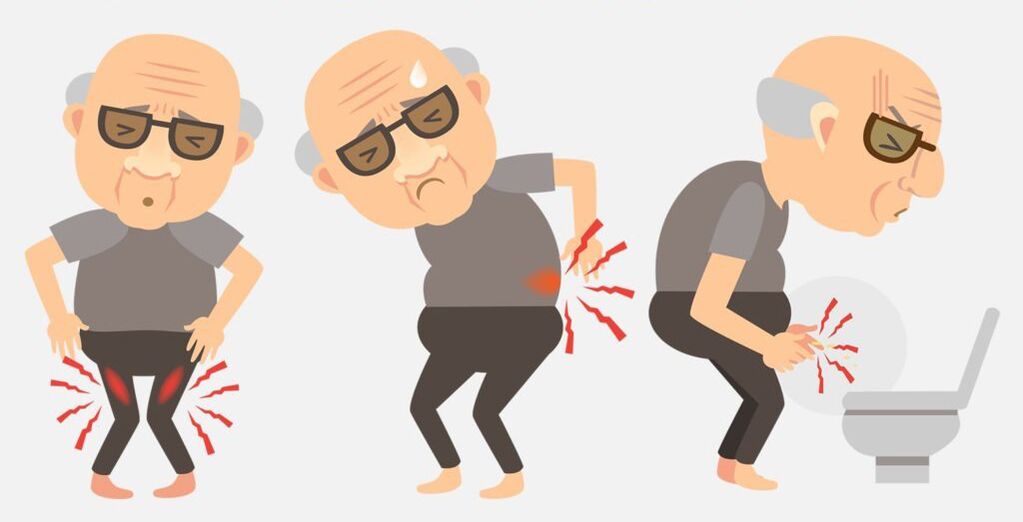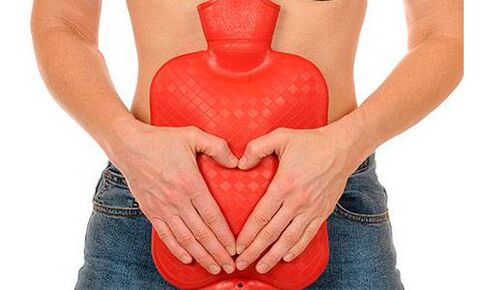In men, the symptoms of prostatitis are not typical or specific, as they may seem at first glance. Therefore, in modern urology and andrology, infertility is increasingly being diagnosed among the most active reproductive layer - men between the ages of 25 and 40. The prostate gland of men is an organ that performs several functions: barrier, regulating blood clotting, endocrine, reproductive, copulatory (sexual), the role of the sphincter of the bladder. In men, the signs and symptoms of prostatitis are manifold, especially in chronic form - they cover all the functions of the organ and often make diagnosis difficult.
Symptoms of acute prostatitis in men

In men, what symptoms of prostatitis should be monitored and a doctor should be consulted? All men, especially at a young and sexually active age, should be aware of the signs of inflammation of the lower genital tract and the possible clinic of incipient prostate disease. Many young people postpone their visit to a urologist with the idea that the disease belongs to an older age group.
Important.
Prostatitis is based on a complex of factors that begin to act at the exact age of 20-30 years.
- Sexual infections are the first things that trigger an active or slow inflammatory process. Chlamydia, mycoplasma infection, gonorrhea, trichomoniasis, gardnerellosis trigger urethritis, against which glanditis can develop. The viruses of herpes simplex, human papilloma, CMV, if not caused by glandular inflammation, significantly exacerbate the course of STIs and "pave the way" for bacteria in the tissue of the organ. Against the background of genital infections, the opportunistic flora (staphylococci, Escherichia coli) often leads to prostate disease. When diagnosed, there is often a mixed flora.
- Prolonged sitting work is one of the causes of illness. Such occupational hazards or habits adversely affect prostate health.
- Arrhythmic sex life - its rarity or randomness, psychological problems causing delayed or absent ejaculation, erectile dysfunction, frequent self-satisfaction - significantly disturbs the balance of arterial and venous blood flow in the gland.
- The effects of the cold on the lumbar region, abdomen and limbs - winter sports and leisure, occupational hazards associated with hypothermia cause irreversible changes in glandular tissues.
Sexual infections, chronic hypothermia, venous blood and stagnation of prostate secretion underlie the development of chronic prostatitis. . . The symptoms of inflammation in different forms of prostatitis are linked to three syndromes: painful, sexual, and dysuria (urinary incontinence). The predominance of one of them is the reason for visiting a doctor - urologist, sexologist, therapist or surgeon. The vigilance and training of the doctor determines the speed of the healing process.
Acute prostatitis, the symptoms of which are observed after or concomitantly with an active genital infection, are characterized by:
- Discomfort and pain while urinating.
- Cut at the beginning or end of urination.
- A common and false urge to use the toilet.
- Pain around the anus, especially when sitting.
- Pain during defecation, feeling full in the rectum.
- Mucosal purulent discharge from the urethra.
- Abdominal pain radiating to the thigh, scrotum, back.
- Fever.
- Sexual dysfunctions.
The severity of symptoms is different in each patient. In addition, only a certain symptom may dominate. However, the acute process often progresses with mild symptoms, which ensures frequent chronicity and an increase in the number of identified cases of chronic prostatitis.
First signs of prostatitis
Symptoms of the onset of prostatitis occur in young men under the guise of acute respiratory infections or in the form of a classic genital infection. Depending on the type of pathogen, the signs of an acute process are clear or can be erased.
Symptoms of gonococcus, Staphylococcus aureus, Escherichia coli-induced prostatitis, and nosocomial infection (after urinary tract manipulation) in men include:
- The patient is caught with a sudden chills that last from half an hour to two hours and end in sweating.
- The temperature rises to 38-40 ° C.
- It is characterized by weakness, severe weakness.
In men, the first symptoms of prostatitis should not be accompanied by typical pain in the pelvis, rectum and groin. . . In addition, sexual weakness is not typical. On the contrary, the catarrhal first stage of the disease is manifested by excessive irritability and premature ejaculation.
Important.
Urogenital chlamydia, which often causes chronic prostatitis, is initially associated with only mild dysuria symptoms.
How do men develop prostatitis, which is triggered by the hematogenous or lymphogenic entry of flora into prostate tissue? These types of diseases associated with common somatic infectious diseases (sinusitis, sore throat, pneumonia, abscesses, pustular skin diseases) are not noticed by the patient. Against the background of the underlying disease, the temperature rises again and the symptoms of poisoning increase, mild dysuria and abdominal pain may develop.
Symptoms of chronic prostatitis in men

Combining bacterial or viral, congestive or infectious chronic prostatitis with a variety of symptoms, inflammatory processes, although caused by various triggers, lead to three basic manifestations:
- Pain syndrome.
- Urinary incontinence.
- Sexual dysfunction.
The symptoms of pain associated with prostatitis can also be divided into three types:
- Extragenital - pain in the rectum, lower back, abdomen.
- Symptoms of pelvic pain do not appear on their own, but severe itching of the anus, tingling, paraesthesia, neurosis, excessive sweating - this is due to the involvement of pelvic nerve braids.
- Genitals - pain in the scrotum, lumbago in the testicles, groin and perineum.
- Mixed.
Symptoms of pain in prostatitis form a term like "chronic pelvic pain syndrome in men. "
Symptoms of inflammation of the chronic form of the prostate gland are accompanied by erection, violation and suppression of ejaculation, and decreased libido. This is due to a neurosis-like syndrome that progresses according to a sympathetic or parasympathetic type. The first is characterized by heartbeats, fever, evening subfebrile state, sudden mood swings, inattention. For the second - drowsiness during the day, fatigue, night insomnia, hypochondria, sweating, weight gain, lump in the throat, excessive salivation.
Among the dysuria phenomena, the increase in urination, the difficulty of emptying the bladder, the lethargy of the stream. Such signs show marked similarity to the adenoma, which sometimes makes diagnosis difficult.
Important.
Chronic prostatitis in men over the age of 45 often occurs concomitantly with prostatic hyperplasia.
In chronic form, spermatorrhea and prostatorrhea are observed - secretion of prostate secretion from the urethra in combination with seminal fluid due to organ atony.
Asymptomatic prostatitis
Prostatitis is not always symptomatic. Often a man is informed of an illness, such as when he or she is performing an ultrasound diagnosis, when he or she is planning to have a child. They find calcification in the tissues of the prostate, clogged ducts, enlargement or shrinkage of the glands, sclerosis, impaired blood flow by Doppler sonography, varicose veins of the prostate and pelvis.
Symptomatic prostatitis develops in young men after sexual infections, especially urogenital chlamydia and mycoplasmosis.Asymptomatic prostatitis is particularly common after inadequate and incomplete treatment of these diseases. Decreases in the number of germ cells, a decrease in actively moving cells, agglutination, and a decrease in lecithin granules are often observed when examining sperm. Intermittent sexual failure is possible, to which the man does not attach importance.

Symptoms of exacerbation of prostatitis
Exacerbation of chronic prostatitis occurs when exposed to harmful provocative factors - general somatic diseases, hypothermia, irregular sexual activity, alcohol consumption, exacerbation of infectious diseases of the urogenital organs.
In men, the symptoms of worsening prostatitis are similar to the onset of the disease. Temperature rise, general malaise, fatigue, weakness, chills come to the fore. Pain in the anus, fullness in the rectum, lumbar in the groin, barrier. Sexual dysfunction and nervousness also worsen. While going to the toilet, patients experience difficulty and increased urination, weakening of the stream, and pain.
Characteristics of the course of some types of prostatitis
How do men develop different types of prostatitis? Traditionally, we distinguish several types of disease depending on the predominant process: infectious, bacterial, stagnant, purulent.
Infectious and bacterial prostatitis
The term includes several nosological forms of the disease, or rather differentiates according to the types of pathogens. Infectious prostatitis, the symptoms of which can only be caused by pathogenic bacteria and viruses, can be triggered by a sexually transmitted and opportunistic pathogenic flora. Conditionally pathogenic microorganisms, which usually live in the male urinary system, cause disease only under the influence of unfavorable factors. Escherichia coli, staphylococcus, enterococcus are most commonly found when sperm and urine are sown. This is bacterial prostatitis.
Infectious prostatitis is predominantly recorded among young people.This type of inflammation of the prostate gland most often becomes chronic and leads to infertility.
The clinical picture is characterized by the highest brightness in gonorrhea, chlamydia, mycoplasmosis, and opportunistic pathogens, and the symptoms are rare and therefore often lead to chronic prostatitis.

Purulent prostatitis
The piogenic flora is represented by gonococci, Pseudomonas aeruginosa, Escherichia coli, a methicillin-resistant strain of Staphylococcus. These microorganisms secrete a number of destructive enzymes, are characterized by aggression against prostate tissues, and therefore initiate purulent fusion.Purulent prostatitis often results in abscess, phlegmon, paraprostatitis, paraproctitis.
The purulent process is often triggered by bacteria that have entered the prostate in the following ways:
- From purulent foci in other organs.
- For medical interventions on the urinary tract. Hospital flora is characterized by multiple antibiotic resistance and therefore leads to purely purulent prostatitis.
Purulent prostatitis, the symptoms of which are most pronounced, often causes complications: urinary and bladder intestinal fistulas. In addition, such bacteria easily penetrate the ascending pathway into the kidneys, pelvis, and chalices, causing chronic inflammation.
Congestive prostatitis
The isolated course of this type of disease is virtually ruled out, as the microbial flora binds to the background of the stagnant processes, and this type acquires an infectious form of the course. Most often, urologists make such a diagnosis if no bacteria have been isolated during inoculation of the biomaterial. In general, analysis after 2-3 weeks already gives a positive result for the bacterial flora.
Venous blood stagnation is often observed in varicose veins, rectal pathology, pelvic tumors, and hypodynamics. Violation of the outflow of prostate secretion, which is most commonly observed in sexual dysfunction and irregular sexual activity, leads to stagnation and preconditions for inflammation.Congestive prostatitis, the symptoms of which coincide with infectious inflammation, are inextricably linked and sequential.Symptoms are complemented by varicose veins and rectal lesions.
It is clear that in the chronic form of prostatitis, the manifestations may not be specific, requiring a thorough comprehensive diagnosis.
Important.
Any sign of a male genital infection is a reason to be treated by a urologist or venereologist.
Self-healing or neglect of the situation can give impetus to the development of the chronic form.
























